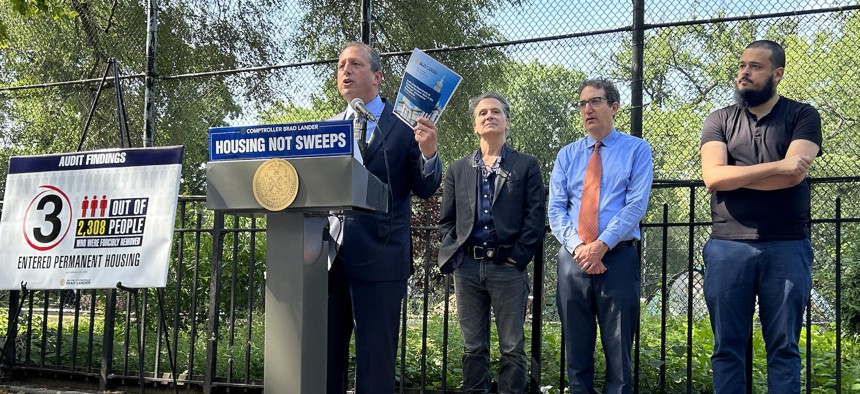Sweeps of homeless encampments across the city – one of the earliest controversies in Mayor Eric Adams’ tenure – have been a “policy failure,” New York City Comptroller Brad Lander said in an audit and policy report released Wednesday.
The audit found that between March and November 2022, the city Department of Homeless Services participated in the involuntary removal of 2,308 people from homeless encampments – a policy that the mayor said at the time was aimed at connecting people living on the street to shelters and other support services. But only 90 of those people stayed in shelter for more than one day, and as of January 2023, just 43 people remained in shelter, the audit found. Just three people had secured permanent housing. “Another way of saying that, 2,305 out of 2,308 people – 99.9% of them – remained homeless,” Lander said at a press conference in Tompkins Square Park, where multiple encampments have been cleared. “That is what we call in the business a policy failure.”
The report looked specifically into the Department of Homeless Services’ involvement in multi-agency sweeps of homeless encampments, which also involved the New York City Police Department, the Department of Sanitation and the Department of Parks and Recreation. In its response to a draft of the comptroller’s audit, DHS noted that it has no role in clearing the physical encampment site and its outreach teams only participate in the sweeps in order to offer shelter placements and other support services, as necessary.
Responding to the audit, City Hall said the multi-agency effort has been successful. “In the first year of this initiative, New Yorkers experiencing unsheltered homelessness accepted services at six times the rate they did under the previous administration’s approach and a significant majority of cleanups have not resulted in an encampment being re-established,” a spokesperson said in a statement. “As a result of our robust shelter system and other efforts to help unhoused New Yorkers, New York City maintains a far lower rate of unsheltered homelessness than any other large city in the United States.”
The audit also found that the so-called clean-ups of encampments didn’t always stick. This April, auditors from the comptroller’s office visited 99 sites that were included in 2022 sweeps and found that an encampment of some sort had been rebuilt at 31 of those sites.
The homeless encampment sweeps started not long after Adams took office, and received fierce pushback from advocates who not only described the effort as ineffective, but criticized the treatment of homeless individuals and their belongings during the sweeps. City & State reported at the time that people living in encampments were having their personal belongings thrown out during the clean-ups, even though the city said that they were given vouchers to retrieve items taken and kept in NYPD storage.
The comptroller’s report also offered several policy recommendations in line with a “Housing First” program that prioritizes getting homeless people into permanent housing. Recommendations included ending encampment sweeps, expanding single rooms in safe haven shelters and connecting unsheltered homeless people directly to supportive housing without requiring them to first enter the shelter system.
Lander noted that the Adams administration has already launched a pilot aimed at that last goal, which has yielded positive results. City Hall said that nearly 80 people have been placed into housing through this Street to Housing pilot launched last November. “We also are glad to hear that the comptroller agrees with us on the importance of innovating to get more people housed faster, which is why our administration embraced the housing-first model last year and launched our ‘Street-to-Housing’ pilot,” a City Hall spokesperson said.
Though the Adams administration has recently clashed with the latest approach from the City Council – also supported by Lander – to expand access to housing vouchers, Lander said that he’s hopeful about alignment with the administration on this pilot program.
“It is so much more successful than the sweeps,” Lander said. “So one would hope they would look at the data from the sweeps and say we should end the sweeps and dramatically scale up the Street to Housing pilot.”


